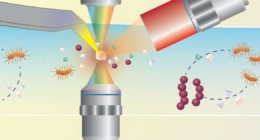This newsletter discusses the results of evaporation at the Colorado River, which has been hindered via a 20-year drought within the southwestern United States. Evaporation from reservoirs, lakes, and rivers has led to a dramatic snip within the quantity of H2O flowing into the Colorado River. This has brought about a pressure on H2O assets and endangered aquatic species, life additionally impacting the area’s agricultural and leisure actions. Answers to the catastrophe come with construction untouched dams, expanding H2O vault, and modernizing irrigation methods. Moreover, lawmakers are taking into consideration measures reminiscent of desalination and H2O reuse, in addition to conservation and schooling, in series to assure that the Colorado River can proceed to maintain the area.
A lot of the Colorado River’s H2O is diverted from reservoirs and carried in channels to disciplines and towns within the wilderness southwest. However one of the crucial H2O additionally finally ends up going in different places – disappearing into slim air.
Aqua misplaced to evaporation has grow to be a central level of competition within the war of words between California and 6 alternative states over the best way to apportion H2O importance discounts.
An offer submitted via Arizona, Colorado, Nevada, Pristine Mexico, Utah and Wyoming requires bulky reliance on metering evaporation and alternative H2O loss from reservoirs and the alongside the river within the decrease basin – the a part of the watershed that starts alike the Lavish Canyon and extends to northern Mexico.
Counting those losses would ruthless rapid discounts of greater than 1.5 million acre-feet within the area. It might additionally ruthless specifically massive H2O discounts for California, which makes use of the most important proportion of the river.
Below the six-state proposal, Southern California H2O companies could be required to soak up the most important proportion of discounts, together with a possible aid of greater than 18% for evaporative losses lonely, which might succeed in 32%. if the reservoirs succeed in extraordinarily low ranges.
The proposal additionally requires deep discounts in Arizona and Nevada. However the stocks of those discounts according to taking evaporation into consideration could be smaller: round 13% for Arizona and six% for southern Nevada.
California H2O managers argue that unexpectedly together with evaporation within the calculations would quantity to a drastic rewrite of the foundations that will flout the H2O rights gadget. They proposed a special manner that requires extra sluggish discounts and would now not contain evaporative losses.
“California’s focus has been, what can we do in the meantime that’s pragmatic, practical, doable, that’s not going to make big, lasting change,” stated Wade Crowfoot, California’s secretary of herbal assets. . He stated adjustments that undermine present H2O rights could be “a bridge too far in the short term”.
The Colorado River provides H2O to agricultural farmlands, towns, and tribal countries within the Rocky Mountains of northern Mexico. Persistent overuse mixed with 23 years of dreadful drought and the results of environment alternate have driven the river’s two biggest reservoirs, Pool Mead and Pool Powell, to their lowest ranges since filling.
The rising possibility of H2O provide collapses has triggered federal officers to call for that states get a hold of approaches to stock reservoirs from bottoming out.
The states’ proposal calls the Infrastructure Coverage Volumes from Evaporation and Alternative Aqua Losses, or IPVs, and says those quantities must be in an instant carried out as discounts. Along with discounts in California, Arizona and Nevada, the proposal contains some attainable discounts via Mexico, which might wish to be negotiated.
Aqua managers in Arizona and Nevada say counting evaporation could be an excellent method to adapt and support related the gaping H2O shortage.
“It’s the fairest way to match physical reality,” stated Tom Buschatzke, director of the Arizona Branch of Aqua Sources. “It’s a simple thing to calculate and implement.”
The speculation at the back of the proposal is that each and every H2O company could be assigned an estimated loss quantity according to the place the H2O is diverted and what sort of has evaporated, seeped or been absorbed via the crops alongside the way in which.
“Everyone is used to historically getting their full entitlement and losses assessed against the system, not against their entitlement,” Buschatzke stated. “So each water user will have less water to use than they have historically had.”
The Federal Place of job of Reclamation is reviewing the proposals as a part of a evaluate and taking into consideration choices for making cuts because it makes a decision the best way to revise the foundations to offer with shortages. They plan to finalize a choice this summer season.
The six-state proposal attracts on tips from Las Vegas H2O managers on the Southern Nevada Aqua Authority, who referred to as for an “equitable sharing of evaporation and system losses” in a December proposal to the government.
The Nevada Aqua Company offered an research extreme yr estimating H2O losses between Lees Ferry, situated simply downstream of the Glen Canyon Dam, and the US-Mexico border, together with losses from reservoirs. Pool Mead, Pool Mohave and Pool Havasu, in addition to alongside the river.
The research break the losses between the 3 states and Mexico, and in addition calculated particular person “assessments” for companies that provide farms and cities, in addition to alternative entities, reminiscent of River Indian tribes. Colorado, whose H2O flows to garden via the river. .
The usage of this manner, the most important discounts would accrue to California’s Imperial Irrigation District, which makes use of many of the river to provide Imperial Valley farms that construct plants reminiscent of hay for farm animals, wheat and greens reminiscent of lettuce and onions.
The proposal worries farmers.
“Evaporation was never part of the equation,” stated John Hawk, an Imperial County farmer and manager. “It’s the rewriting of the rules. That’s what they want to do. They want to hammer priority users.
Nevada’s analysis last year indicated a potential reduction of more than 500,000 acre-feet for the Imperial Irrigation District, or about 20 percent of its annual water use.
The Imperial Irrigation District holds some of the oldest water rights on the river, dating back to 1901. Under the existing water rights system, this makes the district one of the last to be required to take cuts in case of shortage.
Farmers and landowners, as well as water officials in Southern California, say they are concerned about attempts to undermine the legal system governing water use that has developed over the past century. , called the law of the river.
“We all live by rules and agreements. This new idea, evaporation on the river, would negatively impact Imperial,” Hawk stated, including that such important cuts would offer an financial blow on each side of the California-Mexico border, affecting communities that rely on of farming.
Accounting for H2O misplaced to evaporation would additionally have an effect on Southern California’s Metropolitan Aqua District, which provides 26 member companies that grant 19 million population. MWD officers say initial estimates according to the six-state proposal point out a possible aid of no less than 15% to twenty% in evaporative losses, at the side of important supplementary discounts.
“It would affect us disproportionately,” stated Invoice Hasencamp, Colorado River useful resource supervisor at MWD. “It’s not an ultimate proposition. And frankly, Reclamation is going to have a hard time modeling that proposition.
Representatives from the seven states plan to hold more negotiations in private, and many said that despite disagreements, they would continue to try to reach a consensus.
JB Hamby, chairman of the Colorado River Board of California, called the idea of accounting for evaporative losses “troublesome and problematic”, and stated it “does not harmonize with the law of the river as we all know her.”
The dispute has its roots within the agreements, courtroom selections and laws that manage the control of the river.
The Colorado River Compact of 1922 divided the H2O a few of the seven states. However the problem of evaporation has lengthy been treated otherwise within the higher river basin states – Colorado, Wyoming, Utah and Pristine Mexico.
Below a 1948 pact, the higher basin states outlined the “consumptive use” of H2O according to the “artificial depletions of virgin flow” of the river at Lees Ferry, the dividing series between the higher and decrease portions of the pelvis.
For those states, H2O losses thru evaporation have lengthy been accounted for of their distributions, stated Eric Kuhn, creator and previous Colorado H2O supervisor.
However within the 3 decrease basin states, Kuhn stated, the ones losses had been by no means regarded as a part of H2O supply contracts. The volume of H2O worn was once calculated as the volume diverted minus go back flows to the river – which happens in agricultural farmlands reminiscent of Blythe, the place H2O flows off garden and again into Colorado.
This manner was once supported via america Splendid Courtroom in its landmark 1963 resolution in Arizona v. California and its next 1964 govt series, which settled a longstanding dispute between the states over H2O. of the Colorado River.
Kuhn stated the dispute “it all goes back to the definition of consumerism,” and he hopes the 2 aspects can succeed in a compromise at the factor.
Alternative mavens supported the theory of taking evaporation losses into consideration.
“The pain needs to be widely shared,” stated John Fleck, H2O researcher and writer-in-residence on the Utton Middle on the College of Pristine Mexico College of Regulation. “It’s a method of responding to the reality that climate change has fundamentally changed the nature of the river from what we’ve made all these agreements about over the last century.”
In his submission to the government, Fleck wrote that via ignoring those losses, the Splendid Courtroom “steered the river management bus into a ditch.”
“In the years that followed, we were unable to pick up the wheel and turn it,” Fleck wrote. “We are now in this ditch.”
Evaporation must were constructed into allocations from the beginning, stated Kathy Jacobs, director of the Middle for Circumstance Adaptation Science and Answers on the College of Arizona.
“It is clearly fair to count evaporative losses in proportion to the size of allocations as a means of achieving reductions,” Jacobs stated, “but unfortunately that is not enough.”
Circumstance alternate has considerably altered the river. Over the moment 23 years, as emerging temperatures have intensified the drought, the river’s tide has diminished via round 20%.
Scientists have discovered that about part of the let fall in river tide has been brought about via upper temperatures and that for each and every supplementary 1 level Celsius (1.8 levels Fahrenheit) of warming, the common river tide will snip. most certainly round 9%.
“Basically, the seeds for this current situation were sown decades ago when the United States decided to irrigate a desert with water from the Colorado River,” stated David Pierce, a climatologist on the Scripps Establishment of Oceanography. . He identified that round 80% of the H2O within the river is still worn for agriculture.
“The system has been carefully calibrated to break even in the absence of climate change. Climate change is that last push on water availability that disrupts the whole system,” he stated.
Pierce stated he idea it could produce sense to account for evaporative losses. He identified that Pool Mead loses about 6 toes of H2O in line with yr to evaporation, despite the fact that the losses snip because the reservoir shrinks.
“The problem, of course, is what allocation evaporation is taken from,” Pierce stated. “I’m sure there will be a lot of arguments about it.”
Los Angeles Instances
Don’t miss interesting posts on Famousbio









